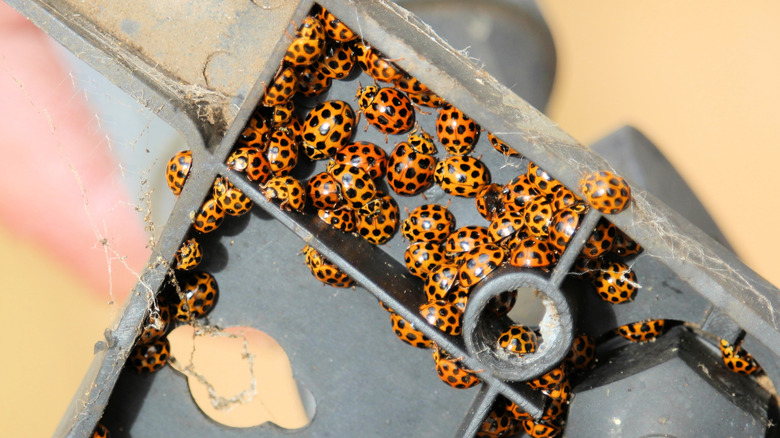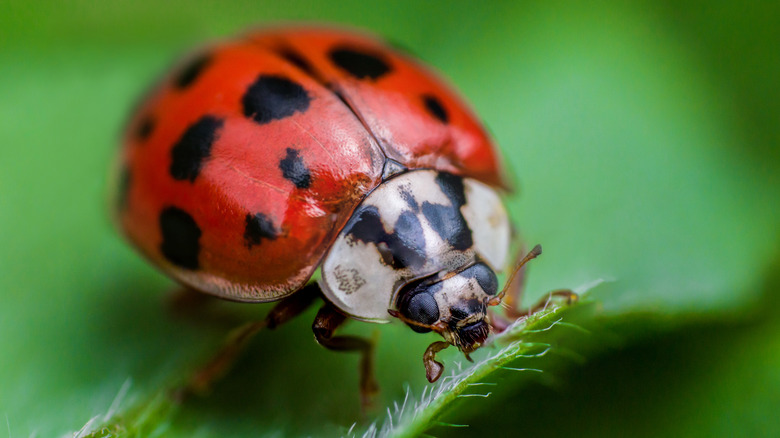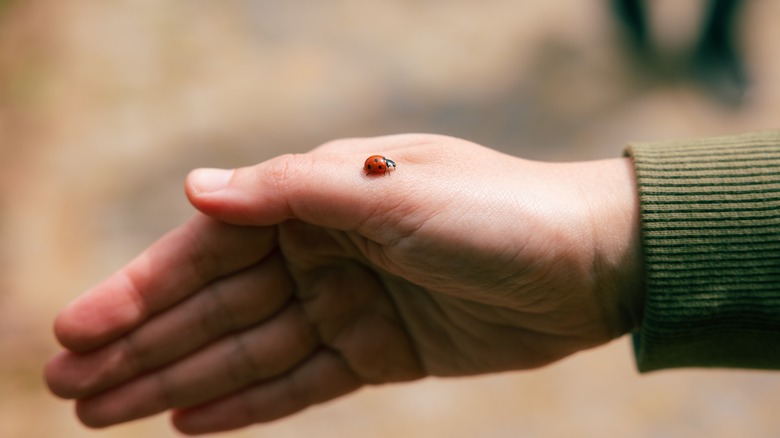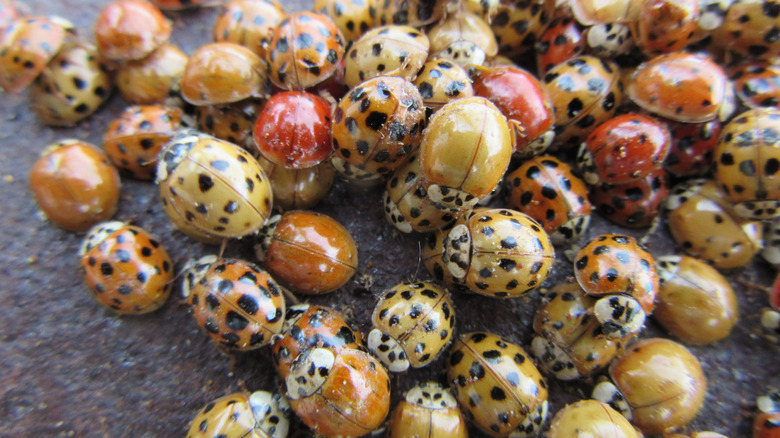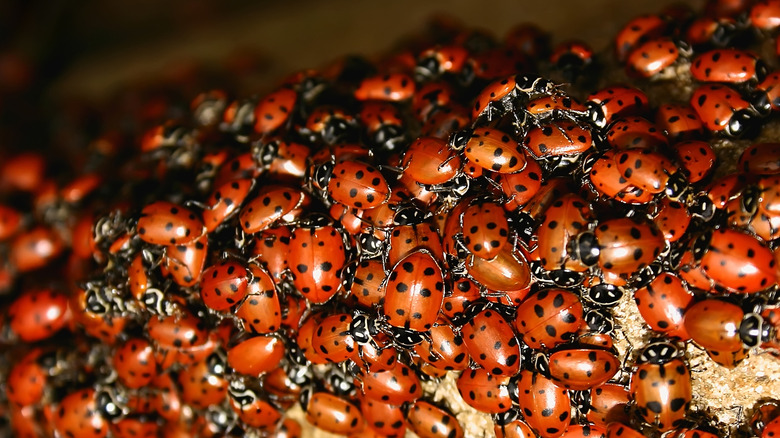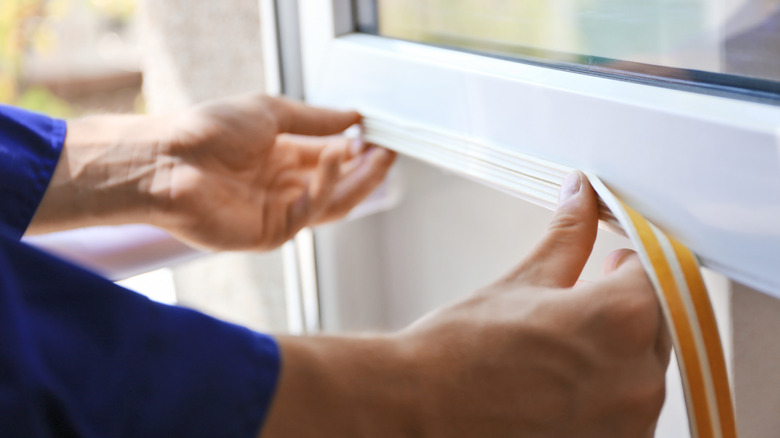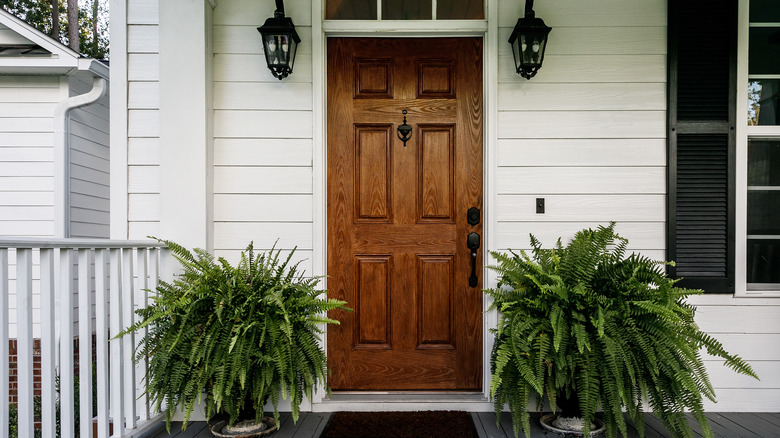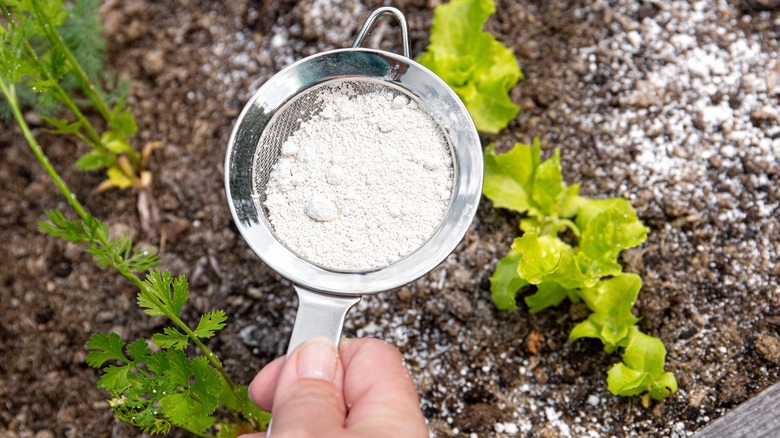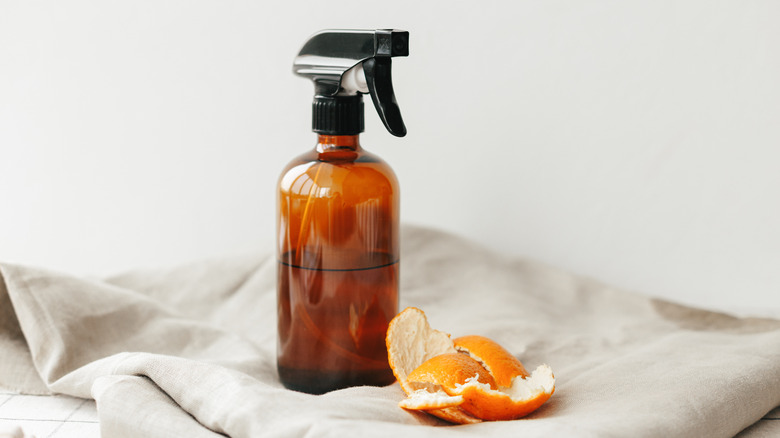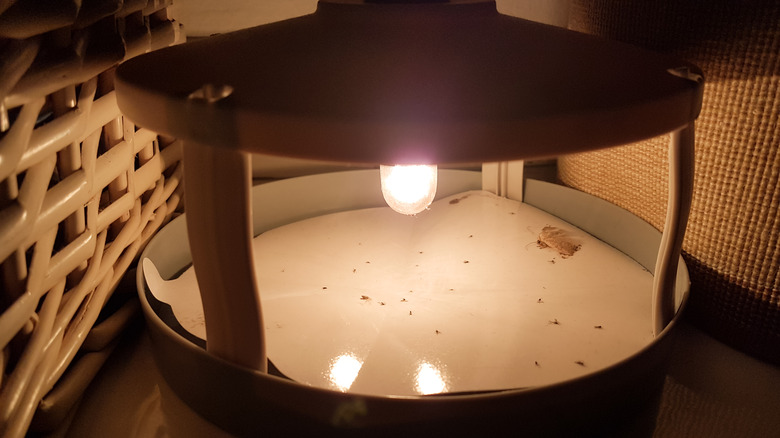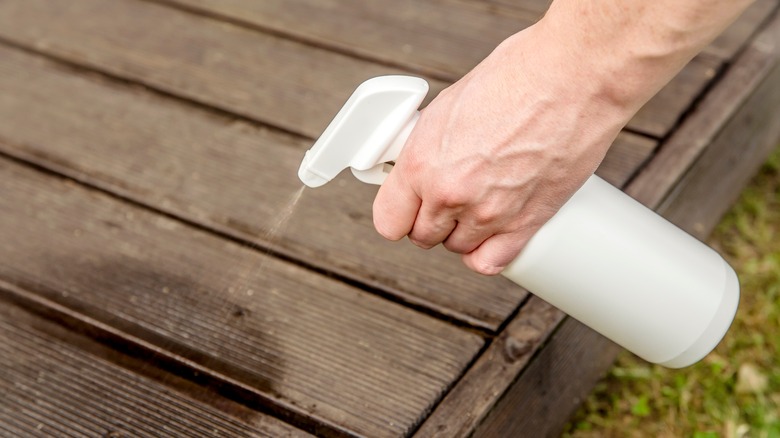How To Get Rid Of Ladybugs Inside The House
Although ladybugs are considered an oath of good luck, according to This Old House, they are everyone's least favorite houseguest, and they are definitely not a joy to discover. You're more likely to see them during the colder time of the year, like winter, but no matter what season of the year it is, ladybugs will always seem to find their way into your home at some point.
According to Prevention, more ladybugs have been seen in homes on a regular occasion starting last winter more than ever all over the country. They are good for the environment, especially your home garden, because they prevent infestations and eat other insects in your yard. They are not an extreme threat at all, but you don't want to get used to seeing them in your home because that means there are families of them.
It's normal for everyone to see one or two ladybugs in your home from time to time, but once they multiply and reproduce, you have a bigger problem on your hands. But, you're in luck because there are ways you can prevent a ladybug takeover in your house, and here you can find the best solutions.
Is it a ladybug or its cousin, an Asian ladybeetle?
The University of California Agriculture and Natural Resources (UCANR) says ladybugs are considered predators, eating up to 5,000 aphids during their lifetime. They also nibble on garden pests like mealybugs and mites. Think all ladybugs are the same? Think again. UCANR says there are 5,000 ladybug species globally. Scientifically, they aren't even considered bugs. They're beetles and are often called by other names, including ladybeetles or ladybirds. Plus, they're not all ladies — there are both male and female ladybugs.
Carolina Pest says people often confuse the ladybug with its cousin, the Asian ladybeetle. The ladybug is red, round, and small, with a calm temperament unless provoked. On the other hand, the Asian ladybeetle is orange, oval, bigger than a ladybug, and can be "aggressive," including biting. If the size and coloring aren't enough to distinguish between the two, look for the white "M" seen behind the Asian ladybeetle's head. Farmers' Almanac notes that American ladybugs have two white circles on their pronotum, which is the shiny black area behind the head. Both may have black dots or spots on their respective protective shells.
Ladybugs can bite you and stain your house
Ladybugs look cute, but they can be a nuisance, potentially harming you. According to The American Academy of Allergy, Asthma & Immunology, ladybugs may cause an allergic reaction in some people, including respiratory problems and swelling under the skin. Healthline reports that they can bite or pinch you as well. A biting study published in American Entomologist showed 26% of the 641 multicolored Asian ladybeetles (MALB) bit the researcher's hands, seemingly having a preference to bite areas of the hands without hair, such as between fingers and on the inside of wrists. Females were slightly shown to bite more than their male counterparts.
Bay Nature says MALB have "reflex bleeding" and release yellow-colored insect blood called hemolymph, which can stain fabrics, furniture, and clothing. AgriLife Today says the bleeding is a defense mechanism: "When they're disturbed, small droplets of blood are released at the leg joints, which apparently defends the beetles against attackers," Dr. Allen Knutson, Texas Cooperative Extension entomologist, told the publication.
Dogs may have an issue as well. Carolina Pest says if an animal eats a beetle, the chemicals released may burn a dog's mouth and digestive tract. But Wizzie Brown, a pest management specialist, told Agrilife there was only one documented case of a dog — known for eating everything — who ate ladybird beetles. "But veterinarians have tried to dispel any hysteria and agree there is really very little concern about their toxicity beyond some possible stomach irritation," she said.
Know your risk factors for a ladybug infestation
A few ladybugs in your house or garden may seem delightful, but you'll likely feel different if there's a swarm. According to A-Alert Exterminating Service, ladybugs like to spend the cool and cold months indoors, in a process called overwintering. While they don't breed, they're sticking around for a while until the weather warms up.
Carolina Pest says they sneak inside through crevices in doors and windows, especially in older homes. They're more likely to take shelter in homes in warmer climates and those that are south-facing, so they'll get lots of sunlight and warmth. They love light-colored homes, too, and they're more likely to move in if your home is close to a field or wooded area.
"There's been a lot of research showing that ladybeetles have pretty good eyesight," North Carolina State University entomologist Mark Waldvogel tells UNC-TV. "They see contrasts well, so they'll notice the shutters around the window."
Once you've had a ladybug infestation, you're more likely to get one again. That's because ladybugs leave behind pheromones that act like a calling call for their friends. Mr. Bugg's Pest Control says fellow ladybugs can detect those pheromones from ¼ mile away.
Infestations happen quickly, so act fast
If you see more and more ladybugs indoors, don't wait to do something about the problem! AAA Exterminating explains ladybugs lay between 10 to 50 eggs every time they breed, which happens many times during the spring and summer. Don't crush ladybugs to get rid of them because you could have a bigger problem to deal with. A-Alert Exterminating Service says when ladybugs die, they release methoxypyrazines. These stinky chemicals can smell like moldy veggies.
A Canadian woman who spotted a swarm of Asian ladybeetles told CBC News that she quickly escaped to her house and locked it up tight to avoid letting her home be a nesting spot. "They landed all on the side of the house. They landed on me. They bite," said the woman, Susan Walsh, who reported seeing the orange pests before, just never so many of them. "It was kind of like Alfred Hitchcock, a smaller oranger version of an Alfred Hitchcock movie."
Seal up your house
Ladybugs are extremely small creatures, so it's not hard for them to get around, stay hidden, or fit into tiny spaces. According to This Old House, ladybugs are attracted to warm, cozy, dark spaces, which makes your home the perfect nesting place for them and their eggs. They produce a chemical discharge that signals the rest of their tribe to find them.
Any open entrance, no matter how big or small, is an open invitation for ladybugs to come into your home, so the best thing you can do to protect your house is to seat it up, according to Farm and Dairy. Seal up every hole or entry from the outside, like windows, cracks, and vents. Get any holes fixed, plugged up, or filled with foam or concrete. Seal up the bottom of each down in your household, especially entry doors such as the front and back. Check for any holes around pipes and wires as well. This can be a consuming task, but it's better to take the time to do this because it's better to be safe than sorry. If ladybugs can't make their way inside your house to begin with, there shouldn't be a problem.
Keep your plants outside
According to NJ Pest Control, you have a much bigger chance of having visits from ladybugs if your home is located near wooded areas as well as fields. I know we all love a good garden in our yard or, even more, likely now, a family of houseplants, but plants, unfortunately, attract ladybugs, according to Pest Strangers. A plant or two may be okay, but the more plants you keep in your home, the more likely you are to have ladybugs trying to find their way inside to them.
If you find yourself bringing outside plants into your home or buying new plants, you want to always deliberately inspect them every time to make sure no ladybugs are present. However, it is in your best interest to try to avoid doing this. Not only will keeping your plants outside keep ladybugs from entering your home but the high possibility of any other insects as well.
Vacuuming is a must
According to Prevention, the most efficient way to get rid of ladybugs in your house is by vacuuming them up. If your vacuum has one, using the handheld piece may be easiest when doing this. Not only is it efficient, but it's also safe for ladybugs because you won't have to kill them.
Simply suck them up through the nozzle and release them outside, but you want to make sure you are a good distance away from your house to avoid the possibility of them entering your home again. This way is simple and easy, and it gets the job done quickly every time. If you don't have a vacuum, you could consider using a broom if it's less than a few that can be easily swept out, but you won't have the same result if it's more than a couple. A broom is more likely to prolong the capture of the ladybugs.
Soap and water go a long way
There are a number of ways to get rid of ladybugs that don't include bringing a toxic chemical into your home and putting yourself at risk. A good natural way to get rid of any unwanted ladybugs in your home you probably didn't think of is to spray them with soap and water.
Pest Strangers recommends simply filling an empty spray bottle with water and dish soap. Lightly shake the bottle to mix the solution, and once that's done, you want to spray them. This will certainly do the trick and make it easier to get rid of the ladybugs because the solution is harmful to them but safe for you. According to Pest Strangers, the solution kills them and also nips in the bud any possibility of the ladybugs returning because ladybugs, as well as any other insects, are repulsed by the scent of the solution. Talk about two for one deal.
Chrysanthemums are your friend
Chrysanthemums, also known as mums, is a flower that ladybugs are heavily repulsed by, according to Pest Strangers. They grow in different colors, shapes, and sizes, and you don't need an entire garden of them to do the trick, but they are extremely helpful in working as a natural ladybug repellent. Ladybugs are not a fan of mums, and they will avoid them at all costs, so planting or buying this flower will definitely do more harm than good.
Consider keeping them in a window space, front or back porch, and at the entry of your front door. If you have a dog or other animals, it's also good to know they're a good solution in preventing fleas, according to Pest Guide. If you're a gardener, this plant will also scare off other unwanted guests, so enjoy bug-free living. Of course, if you feel like you may have a ladybug infestation that's completely out of your hands, consider contacting a pest control company like Terminix or Orkin, as recommended by This Old House.
Sprinkle diatomaceous earth around your home
According to Epic Gardening, using diatomaceous earth around your home, especially in sealed-off areas like windows, awnings, and doorways, will repel ladybugs. Be sure you use food-grade diatomaceous earth, which is safe for humans and pets. Still, wear a mask and gloves when using it since it can cause eye and skin irritation.
Farmers' Almanac says diatomaceous earth comes from the fossilized remains of diatom, a phytoplankton. It's all-natural and odorless. Homestead and Chill says the chalky white powder product is often called "DE" and works on any insect with an exoskeleton. While the substance feels smooth to the human touch, it's sharp to insects' protective outer shells and cuts them, causing them to dry out.
You can buy diatomaceous earth online or at garden and home improvement stores. Dust areas where ladybugs are problematic. If it gets wet, reapply it since water makes it less effective.
Use lavender to repel them
Humans love lavender for how it smells, but it turns out that scent is a big turnoff for ladybugs. According to USA Today, the essential oils found in lavender leaves drive ladybugs and many insects away. While it doesn't kill them, it will repel them from your home. The article suggests hanging dried lavender around the house, including closets.
Insect Cop says a chemical compound called linalool, which is also found in peppermint, oregano, and basil, gives the flower its fragrance. It has an easy DIY recipe for making your own lavender repellent at home: Start with 1.5 ounces of distilled water in a spray bottle, then add 30 to 40 drops of lavender essential oil. Spray it as needed around your home, including doorways, patio furniture, and in any areas where you see unwanted ladybugs. You can also use reed diffusers to pump lavender into the air inside your home, and set up essential oil stations featuring 30 to 40 drops of pure lavender oil in specific areas, such as entryways.
Raid your spice cabinet for natural repellents
Look to your kitchen cabinet to find ingredients to repel ladybugs. Cloves, which come from dried flowers from the clove tree, are known for their antioxidant properties and are often used to spice up foods, as per WebMD. But according to Pest Pointers, that same spice is an effective insecticide. That's because cloves have a strong smell and contain eugenol, which is too potent of a scent for ladybugs. It's also a component found in cinnamon, oregano, turmeric, and ginger (via The Royal Society of Chemistry). Pest Pointers suggests making your own clove spray to repel ladybugs by mixing 10 to 15 drops of pure clove essential oil with 1 cup of water in a spray bottle.
Bay leaves are another natural repellent. JP Pest Services recommends placing bay leaves — either fresh or dry — around the house to keep bugs away. The reason? The leaves have a bitter smell that's a turnoff for ladybugs and other household pests, including moths, mice, and cockroaches.
Citronella's strong smell may repel pests
Get rid of ladybugs like you get rid of mosquitos — with citronella (via AAA Exterminating). The pungent smell of citronella is off-putting for ladybugs, so consider placing citronella candles around your home, especially in areas where you see lots of ladybugs or Asian beetles.
The Environmental Protection Agency (EPA) lists citronella as a minimum-risk pesticide. The National Pesticide Information Center says citronella repels pests, including insects and possibly animals, by masking scents they like, which causes the pests to look elsewhere for food. Pest Pointers recommends placing citronella candles on the front and back porches of your home as a way to prevent ladybugs from coming inside. It also has a DIY citronella oil spray recipe: Combine 1 cup of water with 10 to 15 drops of citronella essential oil. Put the mixture in a spray bottle and spritz it all around the home, including door frames, window sills, vents, and any exterior cracks or openings.
Ladybugs don't like mint
Humans love mint, but ladybugs do not. That's according to Pest Pointers, which says any type of mint from the mint family will deter ladybugs. Here's how it works. According to Mother Earth News, mint, like peppermint, covers the smell ladybugs like (such as their fave food, aphids), and it also irritates them. Plus, menthol in the peppermint gets in the way of the pheromones that ladybugs and other household or garden pests rely on for mating and reproduction. As a bonus, mint is known to keep out fungus too.
There are a few ways to make your own mint repellents. First, you can dry out mint from a plant and sprinkle the mint leaves around the house (via WQAD). Next, you can make your own repellent spray by diluting 10-15 drops of peppermint essential oil in water and spraying the affected areas (via The Novice Homestead). With these tips, your house will smell minty fresh, and hopefully, you'll keep ladybugs away.
Spray vinegar around the house to drive ladybugs away
You probably already have vinegar in your pantry. Use it as a natural way to keep ladybugs out of your space. According to MedicineNet, vinegar is a great repellent for many reasons. It's safe for humans and pets, and it can repel a variety of pests. When you spray the pests directly, the vinegar is highly effective at killing them because of its high acidity. Plus, spraying vinegar breaks up the pheromone trail, which is what helps ladybugs and other bugs follow each other, especially for mating.
Still, it's not entirely effective for getting rid of ladybugs and other pests, especially because it can't break through their hard shell. Vinegar is a strong smell for humans, too, so be careful not to overuse it inside your house. (Or at least pair it with another less pungent smell.) You can use essential oils such as orange peel or tree tea oil with vinegar to create an even more effective repellent.
Light traps can be a solution
Use light to get rid of ladybugs. The Pest Rangers says placing light traps in dark areas around your home's exterior and property can be effective. It recommends using commercial black ultraviolet lights for the best results. Here's how they work: The bright light from the trap attracts ladybugs, flies, and other pests. There are two kinds of traps: ones that use electricity to zap the bugs and others that use sticky glue to trap them (via Terminix).
You'll have some options when choosing the light trap style. The wall-mounted ones are 3 to 5 feet from the floor. Sconces, which look decorative, are usually placed 6 feet above the ground and collect ladybugs and insects in high-traffic areas. Freestanding light traps are a solution for homeowners who need pest control in a lot of areas. Since they're portable, they can be moved around where needed. Another option, ceiling-mounted light traps, can collect higher flying pests, which is why they're about 8 feet off the floor. This one may be taller than needed to trap ladybugs, but it's still an option, especially if the ladybugs are high on your exterior walls.
Will they go away on their own?
The big question about a ladybug infestation is whether it will go away on its own. Maybe, maybe not. It can take time, and they're resilient. According to the University of California Agriculture and Natural Resources, ladybugs won't fly when it's colder than 55 degrees Fahrenheit, and when threatened, they'll play dead. They typically live one year.
While ladybugs are loners and typically stay outside and go dormant and hibernate, Asian ladybeetles are more likely to stay with other beetles and seek shelter inside (via Bangor Daily News). But since it's warm inside, the beetles might not go fully dormant and may die of hunger inside. "If they stayed outside in a more natural setting that gets colder and stays colder, they would stay dormant the whole winter," Charles Armstrong, insect diagnostician at the University of Maine Cooperative Extension, told the publication. "So, in a way they are killing themselves by staying warm."
